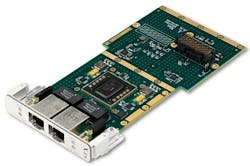Rugged XMC module for sensor interfacing, and traffic aggregation shipping from X-ES
MIDDLETON, Wis., 11 April 2012. Extreme Engineering Solutions (X-ES) in Middleton, Wis., is shipping the XPort3301 dual 10GBASE-T 10 Gigabit Ethernet Express Mezzanine Card (XMC) module for remote sensor interfacing, traffic aggregation, storage, data center networks, and similar embedded computing applications that require high-bandwidth communications.
The XPort3301 is engineered to scale from an air-cooled commercial version that operates in temperatures from 0 to 55 degrees Celsius for commercial embedded computing, to a rugged conduction-cooled version that operates in temperatures from -40 to 85 C for military embedded systems.
With 10GBASE-T support, the XPort3301 provides 10 Gigabit Ethernet communications over standard Category 6A cables and RJ-45 connectors. An eight-lane PCI Express 2.0 XMC interface on the XPort3301 provides the bandwidth necessary to move data at line speed between the dual 10 Gigabit Ethernet interfaces and the host processor.
Features of the card include Intel X540 dual 10 Gigabit Ethernet controller; dual 10GBASE-T 10 Gigabit Ethernet front panel (RJ-45) or rear (P16) interfaces; support for legacy 100BASE-TX and 1000BASE-T operation; x8 PCI Express 2.0 interface to the host module per VITA 42.3; optional support for IEEE1588 or Precision Time Protocol (PTP); support for conduction or air cooling; and software support that includes Linux, VxWorks, and Windows drivers.
For more information contact X-ES online at www.xes-inc.com.
Follow Military & Aerospace Electronics and Avionics Intelligence news updates on Twitter
Related stories
Bandwidth demands of radar and signals intelligence create pressure to refresh XMC and FMC mezzanine board standards
X-ES helps avionics designers attack the costs of ATR system development with 3U VPX development platform
Rugged COM Express Compact mezzanine board for military embedded systems introduced by X-ES.

